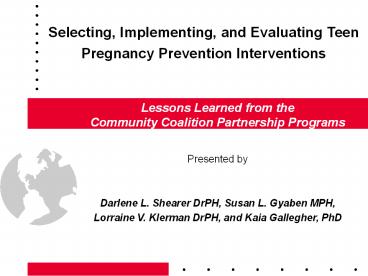Selecting, Implementing, and Evaluating Teen Pregnancy Prevention Interventions - PowerPoint PPT Presentation
Title:
Selecting, Implementing, and Evaluating Teen Pregnancy Prevention Interventions
Description:
Selecting, Implementing, and Evaluating Teen Pregnancy Prevention Interventions ... RHS - Reproductive Health Services - interventions aimed at teens to directly ... – PowerPoint PPT presentation
Number of Views:78
Avg rating:3.0/5.0
Title: Selecting, Implementing, and Evaluating Teen Pregnancy Prevention Interventions
1
Selecting, Implementing, and Evaluating Teen
Pregnancy Prevention Interventions
- Lessons Learned from the
- Community Coalition Partnership Programs
- Presented by
- Darlene L. Shearer DrPH, Susan L. Gyaben MPH,
- Lorraine V. Klerman DrPH, and Kaia Gallegher, PhD
2
Study Purpose and Objectives
- To investigate decision-making processes used
by 13 CDC-funded communities to prioritize,
select, implement and evaluate their
interventions - To describe barriers experienced and lessons
learned during implementation and evaluation - Major Focus on reproductive health services,
reproductive health education, parent-child
communication, male involvement, and programs for
pregnant and parenting teens
3
Definitions
RHS - Reproductive Health Services -
interventions aimed at teens to directly modify
their sexual behavior through the provision of
clinic-type services RHE - Reproductive Health
Education - interventions aimed at modifying teen
sexual behavior through the provision of
sexuality-related education PPT - Pregnant and
Parenting Teens - interventions aimed at
assisting teens medically or educationally to
prevent subsequent pregnancies before reaching
milestones such as high school graduation MI -
Male Involvement - interventions aimed directly
at young males PCC - Parent Child Communication -
interventions aimed primarily at increasing
comfort levels, frequency, and style of
communications between teens and parents
4
Methodology
- Review of semi-annual reports (SARs) to
identify interventions implemented by each of 13
CDC-funded community programs - Developed a telephone survey instrument
- Conducted telephone interviews with Program
Director, Program Evaluator, and Coalition
Chairperson from each of the 13 communities.
5
Study Questions
- What factors influenced community decisions to
develop or not to develop interventions within 5
categories (RHS, RHE, PPT, MI, and PCC)? - How important were community needs and assets
assessments (NAAs) and community action plans
(CAPs) in selection of interventions? - Who were the key entities in decision making?
- What is the current status of each
intervention, what sources of funding have been
used for each and what specific barriers have
been encountered?
6
Analysis
Responses were entered into SPSS and analyzed in
two ways - by type of respondent - by the
intervention category Because responses to
questions were not independent of each other only
descriptive analyses were done.
7
Study Results
- Thirty individuals were interviewed
- 13 Program Directors, 12 Program Evaluators, and
5 Coalition Chairs - Identified 82 interventions in the 5 categories,
an average of 6 per grantee. - Interventions by category
- RHS 13, RHE 43, MI 12, PCC 24 and PPT 7
- Interventions by grantee
- RHE 92, PCC 85, MI 54, RHS 46, and PPT 39
8
Key Decision-Makers in Selection
9
Importance of NAA in Selection
(as reported by Project Directors)
10
Reason for Selection of Category
11
Reason for Not Selecting a Category
12
Implementation Barriers
13
Conclusions
- Grantees relied heavily on their Needs and
Assets Assessments in making decisions about
intervention selection. - Teens were infrequently utilized, while
program staff were the most frequent cited
decision-makers. - The most frequent reason given for not
implementing interventions in a particular
category was that similar programs already
existed. - About two-thirds of the interventions are
being evaluated by process or outcome measures or
a combination of both. - Many respondents did not feel that the (82)
interventions reflected their investment of time
and money or emphasized the importance of their
community-mobilizing and community-awareness
activities.































